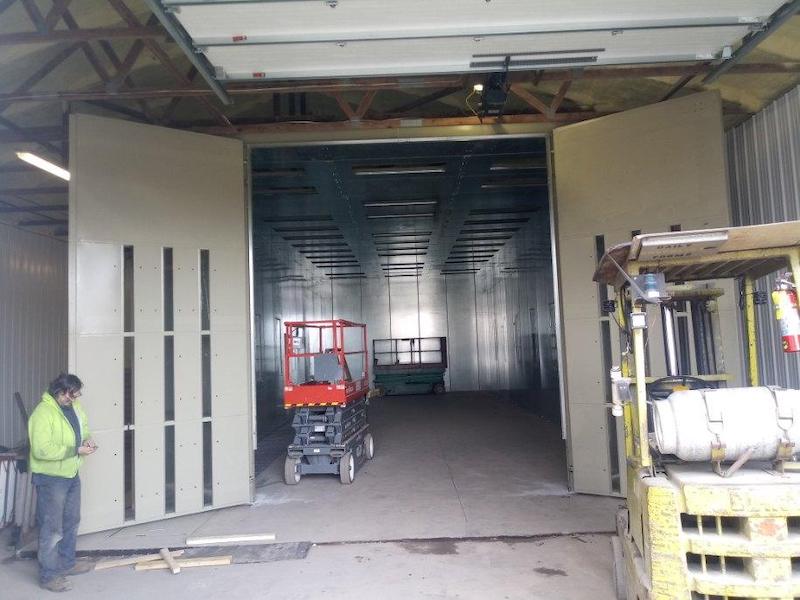Thom Bell has been around the finishing industry for a long time, and thought he had seen it all. He was wrong.
“I’ve been in this business over 40 years,” says Thom Bell, vice president of Precision Finishing Inc, a Clemco distributor in Pennsylvania. “I’ve never seen anything like this. If six months ago you told me that we would start up a 54-by-20 ft blast room with a 50 ft belt conveyer and two bucket elevators—over the Internet—I would have told you that you are full of it.”
In May, a Precision Finishing employee and three employees of MGS Incorporated — the trailer manufacturer in Pennsylvania that purchased the blast room from Precision Finishing — were onsite at MGS. Via video chat, the onsite participants followed instructions from two Clemco employees on how to start up MGS’s new blast room.
“Of course, we weren’t planning on a virtual startup,” says Adam Gildehause, the Clemco field service engineer who led the virtual startup. “But then COVID-19 hit.”
Remote Guidance
Gildehause and Clemco Northeast Territory Manger Nathan Bjornson remotely guided the onsite crew through the usual startup checklist, as well as through extra steps for the blast room’s custom-engineered components. Among other items, they helped the onsite crew determine that the dust collector’s reverse-pulse settings and pulse pressure were correctly calibrated. The also assisted the onsite crew make adjustments to the motors of the blast room’s two bucket elevators, air-wash abrasive cleaner, dust collector, and belt recovery system.
“But for the most part, some belts needed tightening,” Bjornson says. “We helped the crew verified that the two 6-cuft blast machines were operating correctly, and walked through small, routine adjustments.”
The process took only about three hours, according to Craig Martin, Precision Finishing sales engineer, who was onsite for the startup.
“And as soon as it is allowed, Clemco will be here for follow-up,” Martin says. “In the meantime, we can communicate remotely.”
Near-White-Metal Finish
MGS is using the room to blast 48 feet and longer trailer frames to a near-white-metal finish for several military contracts.
“In the past, we may have sent the blasting out to subcontractors,” says Matt Sweigart, MGS vice president of operations, who was onsite for the startup. “But we can’t risk flash rust forming before washing down, priming and then painting the trailers. Now with the blast room, we have in-house control over the entire process.
“It really was an amazing feat,” Sweigart continues. “In March, the entire booth arrived in pieces on pallets. We set up a huge tent outside our facility and spread out the skids. It looked like a giant IKEA order had been unpacked.”
MGS Maintenance Technician Brian Meck was in charge of the installation crew, which varied between four and six employees each shift. He took two weeks to read over hundreds of pages of manuals and instructions, and to also organize the thousands of parts, which ranged in size from tiny washers to 764-pound blast-room doors. He and his crew then had another two months — piece by piece — to build the room. They finished the installation in May and were then ready for the virtual startup.
“The job Clemco did to organize and label those parts was amazing,” Meck says. “Everything was accurately labeled. During the install, we only called Clemco three to five times with questions. It was like putting together a huge jigsaw puzzle.”
Small Hiccups
“Of course, there were small hiccups,” says Mick Lorah, MGS Senior maintenance technician, who also was onsite for the startup. “But the only major issue was because of a mis-measurement from last July when we were preparing to purchase the blast room. We measured the lowest points of ceiling clearance, the rafters, at 14 ft 11 in; the lowest points are actually 14 ft 2 in. The structural ribs of the blast room are 14 ft 7 in.
Lorah, Meck, and Sweigart explain — and laughed — about how crew members used forklifts to squeeze the room’s panels into place with the rooftop ribs of the blast room sliding in between the warehouse ceiling rafters; not to mention slipping in the two bucket elevators, which were each 4 feet taller than the rafters.
“But now we have a perfectly functioning blast room,” Sweigart says. “And those 764 pound doors are hung so tight that you can push them open with your pinky.”
“None of this would have been possible without the teamwork from Clemco and Precision Finishing,” Lorah says. “And especially because of the planning ahead by Brian and the work of his crew. It went a lot quicker than we expected.”
Lane Barnholtz is the senior editor at Clemco Industries Corp., where he writes and edits material about the abrasive blasting industry, such as articles like this for industry publications. Clemco Industries is the world's largest manufacturer of air-powered abrasive blasting equipment.














































